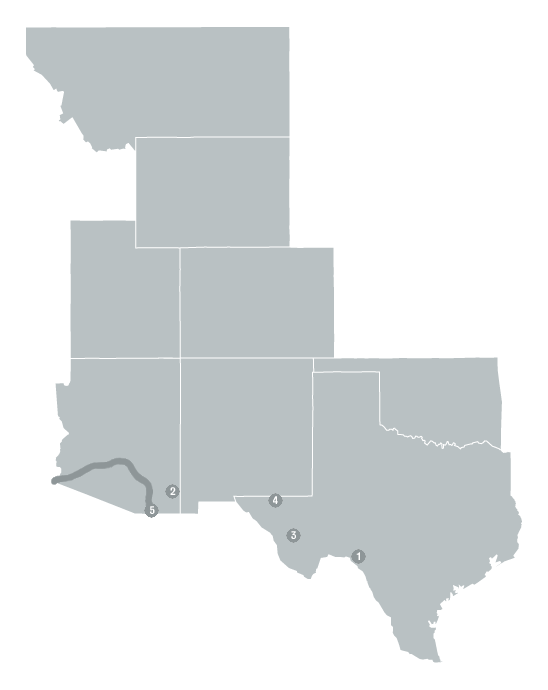Intermountain
Click on the map to explore national parks associated with African Americans.
-
1 |
Amistad National Recreation Area, TX
Black Seminole Indian Scouts and the United States Cavalry participated in the Indian campaigns in this area between 1873 and 1881. The scouts were descendents of runaway slaves who took refuge with the Seminole Indians in Florida. Beginning in 1882, the Black Seminole Indian Scouts helped maintain security for the railroad. They were stationed at Fort Clark in Brackettville, Texas, 30 miles east of this park unit. A descendent community of the Black Seminole Indian Scouts lives in present day Brackettville, Texas and maintains a cemetery where some scouts are buried.
In the 1880s, African Americans were among the laborers recruited to help build the eastern branch of the Galveston, Harrisburg, and San Antonio Railway that runs through this unit.
-
2 |
Chiricahua National Monument, AZ
Following the Civil War, African American soldiers who remained in the United States Army were organized into segregated units including the 9th and 10th Cavalry Regiments. Troops E, H, and I of the 10th Regiment established a semi-permanent camp here in 1885-1886 called Camp Bonita. This camp has been excavated and documented within the park at Bonita Canyon.
-
3 |
Fort Davis National Historic Site, TX
This was one of the first posts in the West where African American soldiers served. From 1867 until 1885, Buffalo Soldiers from the 24th, 25th, and 41st Infantry Regiments and the 9th and 10th Cavalry were stationed at the post. They protected travelers on the San Antonio-El Paso Road and defended against Apache raids during the Indian Wars. Buffalo Soldiers were African American soldiers sent west after 1866 to facilitate western expansion by non-Native American settlers. They were given the nickname Buffalo Soldiers by the South Plains Indians.
Fort Davis was also the place where Lt. Henry O. Flipper, the first African American graduate from West Point, was charged with misconduct in 1882. He was court-martialed and dismissed while his protests that a prejudiced colonel had unfairly treated him were ignored. Ninety four years after his dismissal, the army reexamined the documents of his trial and concluded that the punishment had not fit the crime. The record was changed to give him an honorable discharge, and, in 1978, his body was re-interred in Thomasville, GA with full military honors. In 1999, President Clinton pardoned Lt. Flipper in a ceremony with the Lieutenant's family at the White House.
-
4 |
Guadalupe Mountains National Park, TX
The African American 9th and 10th Cavalry were stationed in the Guadalupe Mountains from 1867 until 1880. The park honors these men with living history presentations on the Buffalo Soldiers, the name given to the African American regiments by the South Plains Indians.
-
5 |
Juan Bautista de Anza National Historic Trail, AZ
Some of the members of De Anza's expedition were African American and almost all had mixed European, African, and Native American backgrounds.The trail starts at Tumacacori National Historical Park.


